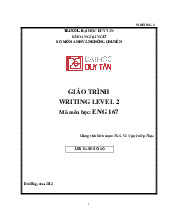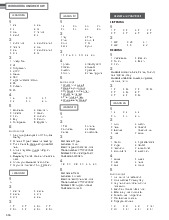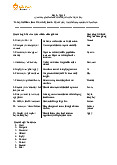



















Preview text:
IELTS'Writing'Task'1'Simon' Contents'
1.! Line graph ................................................................................................................................ 2!
1.1.! Tips for Line graph ........................................................................................................... 2!
1.2.! Internet Users as percentage of population ...................................................................... 3!
1.3.! Internatioal migration in UK ............................................................................................ 4!
1.4.! UK acid rain emission ...................................................................................................... 5!
1.5.! Water consumption .......................................................................................................... 6!
1.6.! Car ownership .................................................................................................................. 7!
2.! Bar chart .................................................................................................................................. 8!
2.1.! Marriages and divorces .................................................................................................... 8!
2.2.! Levels of participation ...................................................................................................... 9!
2.3.! Consumer good .............................................................................................................. 11!
2.4.! House prices ................................................................................................................... 12!
3.! Table ...................................................................................................................................... 13!
3.1.! Tips for table .................................................................................................................. 13!
3.2.! Rail networks .................................................................................................................. 14!
3.3.! Poverty proportion in Australia ...................................................................................... 15!
3.4.! Daily activities ................................................................................................................ 16!
3.5.! Goods consumer ............................................................................................................. 17!
4.! Pie chart ................................................................................................................................. 17!
4.1.! Cam7, page 101 .............................................................................................................. 18!
4.2.! Diet ................................................................................................................................. 18!
5.! Map ........................................................................................................................................ 20!
5.1.! Village of Chorleywood ................................................................................................. 20!
5.2.! Gallery ............................................................................................................................ 21!
5.3.! House design .................................................................................................................. 22!
5.4.! 2 proposed supermarket ................................................................................................. 23!
6.! Process ................................................................................................................................... 24! Writing'Task'1'-'Simon' Page'1'
6.1.! Tips for process diagram ................................................................................................ 24!
6.2.! Forecast in Australia ....................................................................................................... 25!
6.3.! Brick manufactuting ....................................................................................................... 26!
6.4.! Water cycle ..................................................................................................................... 27! 1. Line graph 1.1. Tips for Line graph
Line graphs always show changes over time. Here's some advice about how to describe them:
• Try to write 4 paragraphs - introduction, summary of main points, 2 detail paragraphs.
• For your summary paragraph, look at the "big picture" - what changes happened to all of
the lines from the beginning to the end of the period shown (i.e. from the first year to the
last). Is there a trend that all of the lines follow (e.g. an overall increase)?
• You don't need to give numbers in your summary paragraph. Numbers are specific
details. Just mention general things like 'overall change', 'highest' and 'lowest', without giving specific figures.
• Never describe each line separately. The examiner wants to see comparisons.
• If the graph shows years, you won't have time to mention all of them. The key years to
describe are the first year and the last year. You should also mention any 'special' years
(e.g. a peak or a significant rise/fall).
• Start describing details (paragraph 3) with a comparison of the lines for the first year
shown on the graph (e.g. in 1990, the number of...).
• Use the past simple (increased, fell) for past years, and 'will' or 'is expected/predicted to' for future years.
• Don't use the passive (e.g. the number was increased), continuous (e.g. the number was
increasing), or perfect tenses (e.g. the number has increased). Writing'Task'1'-'Simon' Page'2'
1.2. Internet Users as percentage of population
The line graph compares the percentage of people in three countries who used the Internet between 1999 and 2009.
It is clear that the proportion of the population who used the Internet increased in each country
over the period shown. Overall, a much larger percentage of Canadians and Americans had
access to the Internet in comparison with Mexicans, and Canada experienced the fastest growth in Internet usage.
In 1999, the proportion of people using the Internet in the USA was about 20%. The figures for
Canada and Mexico were lower, at about 10% and 5% respectively. In 2005, Internet usage in
both the USA and Canada rose to around 70% of the population, while the figure for Mexico reached just over 25%.
By 2009, the percentage of Internet users was highest in Canada. Almost 100% of Canadians
used the Internet, compared to about 80% of Americans and only 40% of Mexicans. Writing'Task'1'-'Simon' Page'3'
1.3. International migration in UK
The chart gives information about UK immigration, emigration and net migration between 1999 and 2008.
Both immigration and emigration rates rose over the period shown, but the figures for
immigration were significantly higher. Net migration peaked in 2004 and 2007.
In 1999, over 450,000 people came to live in the UK, while the number of people who emigrated
stood at just under 300,000. The figure for net migration was around 160,000, and it remained at
a similar level until 2003. From 1999 to 2004, the immigration rate rose by nearly 150,000
people, but there was a much smaller rise in emigration. Net migration peaked at almost 250,000 people in 2004.
After 2004, the rate of immigration remained high, but the number of people emigrating
fluctuated. Emigration fell suddenly in 2007, before peaking at about 420,000 people in 2008. As
a result, the net migration figure rose to around 240,000 in 2007, but fell back to around 160,000 in 2008. (159) Writing'Task'1'-'Simon' Page'4' 1.4. UK acid rain emission
The graph below shows UK acid rain emissions, measured in millions of tones, from four
different sectors between 1990 and 2007.
I've made the following essay into a gap-fill exercise.
The line graph compares four sectors in ______ of the amount of acid rain emissions that they
produced over a period of 17 years in the UK.
It is clear that the total amount of acid rain emissions in the UK ______ ______ between 1990
and 2007. The most ______ decrease was seen in the electricity, gas and water supply sector.
In 1990, around 3.3 million tones of acid rain emissions came from the electricity, gas and water
sector. The transport and communication sector was ______ for about 0.7 million tones of
emissions, while the domestic sector ______ around 0.6 million tones. Just over 2 million tones
of acid rain gases came from other industries.
Emissions from electricity, gas and water supply fell dramatically to only 0.5 million tones in
2007, a ______ of almost 3 million tones. While acid rain gases from the domestic sector and
other industries fell gradually, the transport sector ______ a small increase in emissions, ______
a peak of 1 million tones in 2005.
Fill the gaps using these words:
produced, reaching fell, responsible, saw, considerably, terms, drop, dramatic Writing'Task'1'-'Simon' Page'5' 1.5. Water consumption
The graph and table below give information about water use worldwide and water
consumption in two different countries.
The charts compare the amount of water used for agriculture, industry and homes around the
world, and water use in Brazil and the Democratic Republic of Congo.
It is clear that global water needs rose significantly between 1900 and 2000, and that agriculture
accounted for the largest proportion of water used. We can also see that water consumption was
considerably higher in Brazil than in the Congo.
In 1900, around 500km³ of water was used by the agriculture sector worldwide. The figures for
industrial and domestic water consumption stood at around one fifth of that amount. By 2000,
global water use for agriculture had increased to around 3000km³, industrial water use had risen
to just under half that amount, and domestic consumption had reached approximately 500km . ³
In the year 2000, the populations of Brazil and the Congo were 176 million and 5.2 million
respectively. Water consumption per person in Brazil, at 359m ,
³ was much higher than that in the Congo, at only 8m ,
³ and this could be explained by the fact that Brazil had 265 times more irrigated land. (184 words, band 9) Writing'Task'1'-'Simon' Page'6' 1.6. Car ownership
The graph below gives information about car ownership in Britain from 1971 to 2007.
The graph shows changes in the number of cars ______ household in Great Britain ______ a period of 36 years.
Overall, car ownership in Britain increased ______ 1971 and 2007. In particular, the number of
households with two cars rose, while the number of households ______ a car fell.
In 1971, ______ half of all British households did not have regular use of a car. Around 44% of
households had one car, but only about 7% had two cars. It was uncommon for families to own
three or more cars, ______ around 2% of households falling into this category.
The one-car household was the most common type from the late 1970’s ______, although there
was little change in the ______ for this category. The biggest change was seen in the proportion
of households without a car, which fell steadily over the 36-year period ______ around 25% in
2007. In contrast, the proportion of two-car families rose steadily, reaching about 26% in 2007,
and the proportion of households with more than two cars rose ______ around 5%.
Fill the gaps in the essay with the following words:
almost, to, figures, per, between, by, over, with, without, onwards Writing'Task'1'-'Simon' Page'7' 2. Bar chart 2.1. Marriages and divorces
The first bar chart shows changes in the number of marriages and divorces in the USA, and the
second chart shows figures for the marital status of American adults in 1970 and 2000.
It is clear that there was a fall in the number of marriages in the USA between 1970 and 2000.
The majority of adult Americans were married in both years, but the proportion of single adults was higher in 2000.
In 1970, there were 2.5 million marriages in the USA and 1 million divorces. The marriage rate
remained stable in 1980, but fell to 2 million by the year 2000. In contrast, the divorce rate
peaked in 1980, at nearly 1.5 million divorces, before falling back to 1 million at the end of the period. Writing'Task'1'-'Simon' Page'8'
Around 70% of American adults were married in 1970, but this figure dropped to just under 60%
by 2000. At the same time, the proportion of unmarried people and divorcees rose by about 10%
in total. The proportion of widowed Americans was slightly lower in 2000. (174) 2.2. Levels of participation
The charts below show the levels of participation in education and science in developing and
industrialised countries in 1980 and 1990.
The three bar charts show average years of schooling, numbers of scientists and technicians, and
research and development spending in developing and developed countries. Figures are given for 1980 and 1990. Writing'Task'1'-'Simon' Page'9'
It is clear from the charts that the figures for developed countries are much higher than those for
developing nations. Also, the charts show an overall increase in participation in education and science from 1980 to 1990.
People in developing nations attended school for an average of around 3 years, with only a slight
increase in years of schooling from 1980 to 1990. On the other hand, the figure for industrialised
countries rose from nearly 9 years of schooling in 1980 to nearly 11 years in 1990.
From 1980 to 1990, the number of scientists and technicians in industrialised countries almost
doubled to about 70 per 1000 people. Spending on research and development also saw rapid
growth in these countries, reaching $350 billion in 1990. By contrast, the number of science
workers in developing countries remained below 20 per 1000 people, and research spending fell
from about $50 billion to only $25 billion. (187 words) Writing'Task'1'-'Simon' Page'1 ' 0 2.3. Consumer good
The bar chart compares consumer spending on six different items in Germany, Italy, France and Britain.
It is clear that British people spent significantly more money than people in the other three
countries on all six goods. Of the six items, consumers spent the most money on photographic film.
People in Britain spent just over £170,000 on photographic film, which is the highest figure
shown on the chart. By contrast, Germans were the lowest overall spenders, with roughly the
same figures (just under £150,000) for each of the six products.
The figures for spending on toys were the same in both France and Italy, at nearly £160,000.
However, while French people spent more than Italians on photographic film and CDs, Italians Writing'Task'1'-'Simon' Page'1 ' 1
paid out more for personal stereos, tennis racquets and perfumes. The amount spent by French
people on tennis racquets, around £145,000, is the lowest figure shown on the chart. (154 words) 2.4. House prices
The bar chart compares the cost of an average house in five major cities over a period of 13 years from 1989.
We can see that house prices fell overall between 1990 and 1995, but most of the cities saw
rising prices between 1996 and 2002. London experienced by far the greatest changes in house
prices over the 13-year period.
Over the 5 years after 1989, the cost of average homes in Tokyo and London dropped by around
7%, while New York house prices went down by 5%. By contrast, prices rose by approximately
2% in both Madrid and Frankfurt.
Between 1996 and 2002, London house prices jumped to around 12% above the 1989 average.
Homebuyers in New York also had to pay significantly more, with prices rising to 5% above the
1989 average, but homes in Tokyo remained cheaper than they were in 1989. The cost of an
average home in Madrid rose by a further 2%, while prices in Frankfurt remained stable. (165) Writing'Task'1'-'Simon' Page'1 ' 2 3. Table 3.1. Tips for table
Tables seem difficult when they contain a lot of numbers. Here's some advice:
• Try to write 4 paragraphs - introduction, summary of main points, 2 detail paragraphs.
• Before you start writing, highlight some key numbers. Choose the biggest number in each
category in the table (i.e. in each column and row). If the table shows years, look for the
biggest changes in numbers over the time period. You could also mention the smallest
numbers, but you can ignoe 'middle' numbers (neither biggest nor smallest).
• For your summary paragraph, try to compare whole categories (columns or rows) rather
than individual 'cells' in the table. If you can't compare whole categories, compare the
biggest and smallest number. Write 2 sentences for the summary.
• In your two 'details' paragraphs, never describe each category (column or row) separately.
The examiner wants to see comparisons. Try to organise the numbers you highlighted
into 2 groups - one for each paragraph (e.g. highest numbers for all categories together, and lowest numbers together).
• Describe / compare the numbers you highlighted - include at least 3 numbers in each paragraph.
• Use the past simple for past years, and 'will' or 'is expected/predicted to' for future years.
If no time is shown, use the present simple. Writing'Task'1'-'Simon' Page'1 ' 3 3.2. Rail networks
The table below gives information about the underground railway systems in six cities. Full essay (band 9):
The table shows data about the underground rail networks in six major cities.
The table compares the six networks in terms of their age, size and the number of people who
use them each year. It is clear that the three oldest underground systems are larger and serve
significantly more passengers than the newer systems.
The London underground is the oldest system, having opened in 1863. It is also the largest
system, with 394 kilometres of route. The second largest system, in Paris, is only about half the
size of the London underground, with 199 kilometres of route. However, it serves more people
per year. While only third in terms of size, the Tokyo system is easily the most used, with 1927 million passengers per year.
Of the three newer networks, the Washington DC underground is the most extensive, with 126
kilometres of route, compared to only 11 kilometres and 28 kilometres for the Kyoto and Los
Angeles systems. The Los Angeles network is the newest, having opened in 2001, while the
Kyoto network is the smallest and serves only 45 million passengers per year. (185 words) Writing'Task'1'-'Simon' Page'1 ' 4
3.3. Poverty proportion in Australia
The table below shows the proportion of different categories of families living in poverty in Australia in 1999.
The table gives information about poverty rates among six types of household in Australia in the year 1999.
It is noticeable that levels of poverty were higher for single people than for couples, and people
with children were more likely to be poor than those without. Poverty rates were considerably lower among elderly people.
Overall, 11% of Australians, or 1,837,000 people, were living in poverty in 1999. Aged people
were the least likely to be poor, with poverty levels of 6% and 4% for single aged people and aged couples respectively.
Just over one fifth of single parents were living in poverty, whereas only 12% of parents living
with a partner were classed as poor. The same pattern can be seen for people with no children:
while 19% of single people in this group were living below the poverty line, the figure for
couples was much lower, at only 7%. (150 words, band 9) Writing'Task'1'-'Simon' Page'1 ' 5 3.4. Daily activities
The chart below shows average hours and minutes spent by UK males and females on different daily activities.
I've made the following essay into a gap-fill exercise.
The table compares the average ______ of time per day that men and women in the UK spend ______ different activities.
It is clear that people in the UK spend more time ______ than doing any other daily activity.
Also, there are significant differences between the time ______ by men and women on
employment/study and housework.
On average, men and women in the UK ______ for about 8 hours per day. Leisure ______
______ the second largest proportion of their time. Men spend 5 hours and 25 minutes doing
various leisure activities, such as watching TV or doing sport, ______ women have 4 hours and 53 minutes of leisure time.
It is noticeable that men work or study for an average of 79 minutes more than women every
day. By contrast, women spend 79 minutes more than men doing housework, and they spend
______ ______ as much time looking after children.
Fill the gaps using these words: doing, up, over, spent, while, sleeping, sleep, twice, amount, takes Writing'Task'1'-'Simon' Page'1 ' 6 3.5. Goods consumer
The table below gives information on consumer spending on different items in five different countries in 2002.
Percentage of national consumer expenditure by category - 2002
The table shows percentages of consumer expenditure for three categories of products and
services in five countries in 2002.
It is clear that the largest proportion of consumer spending in each country went on food, drinks
and tobacco. On the other hand, the leisure/education category has the lowest percentages in the table.
Out of the five countries, consumer spending on food, drinks and tobacco was noticeably higher
in Turkey, at 32.14%, and Ireland, at nearly 29%. The proportion of spending on leisure and
education was also highest in Turkey, at 4.35%, while expenditure on clothing and footwear was
significantly higher in Italy, at 9%, than in any of the other countries.
It can be seen that Sweden had the lowest percentages of national consumer expenditure for
food/drinks/tobacco and for clothing/footwear, at nearly 16% and just over 5% respectively.
Spain had slightly higher figures for these categories, but the lowest figure for leisure/education, at only 1.98%. (155) 4. Pie chart Writing'Task'1'-'Simon' Page'1 ' 7 4.1. Cam7, page 101
The pie charts compare the amount of electricity produced using five different sources of fuel in
two countries over two separate years.
Total electricity production increased dramatically from 1980 to 2000 in both Australia and
France. While the totals for both countries were similar, there were big differences in the fuel sources used.
Coal was used to produce 50 of the total 100 units of electricity in Australia in 1980, rising to
130 out of 170 units in 2000. By contrast, nuclear power became the most important fuel source
in France in 2000, producing almost 75% of the country’s electricity.
Australia depended on hydro power for just under 25% of its electricity in both years, but the
amount of electricity produced using this type of power fell from 5 to only 2 units in France. Oil,
on the other hand, remained a relatively important fuel source in France, but its use declined in
Australia. Both countries relied on natural gas for electricity production significantly more in
1980 than in 2000. (170 words) 4.2. Diet Writing'Task'1'-'Simon' Page'1 ' 8
Fill the gaps with these words:
constitutes, drops, amount, fifth, higher, make, one, relative, figure, up
The pie charts compare the proportion of carbohydrates, protein and fat in three different diets,
namely an average diet, a healthy diet, and a healthy diet for sport.
It is noticeable that sportspeople require a diet comprising a significantly higher proportion of
carbohydrates than an average diet or a healthy diet. The average diet contains the lowest
percentage of carbohydrates but the highest proportion of protein.
Carbohydrates ______ ______ 60% of the healthy diet for sport. This is 10% ______ than the
proportion of carbohydrates in a normal healthy diet, and 20% more than the proportion in an
average diet. On the other hand, people who eat an average diet consume a greater ______
______ of protein (40%) than those who eat a healthy diet (30%) and sportspeople (25%).
The third compound shown in the charts is fat. Fat ______ exactly ______ ______ of both the
average diet and the healthy diet, but the ______ ______ to only 15% for the healthy sports diet. Writing'Task'1'-'Simon' Page'1 ' 9 5. Map 5.1. Village of Chorleywood
The map shows the growth of a village called Chorleywood between 1868 and 1994.
It is clear that the village grew as the transport infrastructure was improved. Four periods of
development are shown on the map, and each of the populated areas is near to the main roads, the railway or the motorway.
From 1868 to 1883, Chorleywood covered a small area next to one of the main roads.
Chorleywood Park and Golf Course is now located next to this original village area. The village
grew along the main road to the south between 1883 and 1922, and in 1909 a railway line was
built crossing this area from west to east. Chorleywood station is in this part of the village.
The expansion of Chorleywood continued to the east and west alongside the railway line until
1970. At that time, a motorway was built to the east of the village, and from 1970 to 1994,
further development of the village took place around motorway intersections with the railway and one of the main roads. (174) Writing'Task'1'-'Simon' Page'2 ' 0



